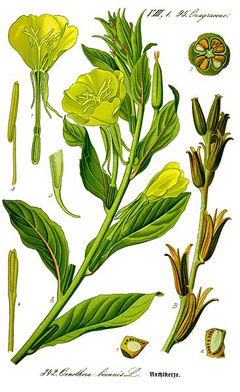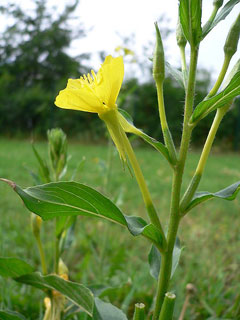 |
|
|
 |
| http://commons.wikimedia.org/wiki/User:Georg_Slickers |
Translate this page:
Summary
Physical Characteristics

 Oenothera bien is a BIENNIAL growing to 1.2 m (4ft).
Oenothera bien is a BIENNIAL growing to 1.2 m (4ft).
See above for USDA hardiness. It is hardy to UK zone 4 and is not frost tender. It is in flower from June to September, and the seeds ripen from August to October. The species is hermaphrodite (has both male and female organs) and is pollinated by Lepidoptera (Moths & Butterflies), bees. The plant is self-fertile.
It is noted for attracting wildlife.
Suitable for: light (sandy) and medium (loamy) soils, prefers well-drained soil and can grow in nutritionally poor soil. Suitable pH: mildly acid, neutral and basic (mildly alkaline) soils. It cannot grow in the shade. It prefers dry or moist soil and can tolerate drought.
UK Hardiness Map
US Hardiness Map
Synonyms
Onagra biennis. Brunyera biennis. Oenothera muricata. Onagra muricata.
Plant Habitats
Edible Uses
Root - cooked. Boiled and eaten like salsify[4, 12, 27, 33, 66]. Fleshy, sweet and succulent[74]. Wholesome and nutritious[2]. A peppery taste[159]. The taste somewhat resembles salsify or parsnips[183]. Young shoots - raw or cooked[2, 12, 52, 85, 183]. Mucilaginous, with a peppery flavour, they are best used sparingly[159]. Another source suggests that the shoots should not be eaten[9]. Flowers - sweet. Used in salads or as a garnish[183]. Young seedpods - cooked. Steamed[183]. The seed contains 28% of a drying oil[114]. It is edible and a very good source of gamma-linolenic acid[141], an essential fatty acid that is not found in many plant sources and has numerous vital functions in the body. The seed, however, is very small and difficult to harvest, it has to be done by hand[160]. Overall yields are low, making the oil very expensive to produce.
References More on Edible Uses
Medicinal Uses
Plants For A Future can not take any responsibility for any adverse effects from the use of plants. Always seek advice from a professional before using a plant medicinally.
The bark and the leaves are astringent and sedative[4, 21]. They have proved of use in the treatment of gastro-intestinal disorders of a functional origin, whooping cough and asthma[4]. A syrup made from the flowers is also an effective treatment for whooping cough[7]. The bark is stripped from the flowering stem and dried for later use, the leaves are also harvested and dried at this time[4]. Evening primrose oil has become a well-known food supplement since the 1980's. Research suggests that the oil is potentially very valuable in the treatment of multiple sclerosis, pre-menstrual tension, hyperactivity etc[66]. It is also taken internally in the treatment of eczema, acne, brittle nails, rheumatoid arthritis and alcohol-related liver damage[238]. Regular consumption of the oil helps to reduce blood cholesterol levels and lower the blood pressure[21, 66]. The seed is a good source of gamma-linolenic acid, an unsaturated fatty acid which assists the production of hormone-like substances[222, 238]. This process is commonly blocked in the body, causing disorders that affect the uterine muscles, nervous system and metabolism[238]. The poulticed root is applied to piles and bruises[222]. A tea made from the roots is used in the treatment of obesity and bowel pains[222].
References More on Medicinal Uses
The Bookshop: Edible Plant Books
Our Latest books on Perennial Plants For Food Forests and Permaculture Gardens in paperback or digital formats.

Edible Tropical Plants
Food Forest Plants for Hotter Conditions: 250+ Plants For Tropical Food Forests & Permaculture Gardens.
More

Edible Temperate Plants
Plants for Your Food Forest: 500 Plants for Temperate Food Forests & Permaculture Gardens.
More

More Books
PFAF have eight books available in paperback and digital formats. Browse the shop for more information.
Shop Now
Other Uses
The oil from the seed is added to skin preparations and cosmetics. It is often combined with vitamin E to prevent oxidation[238]. A yellow dye is obtained from the flowers[7]. A finely ground powder made from the flowering stems is used cosmetically in face-masks to counteract reddened skins[7].
Special Uses
References More on Other Uses
Cultivation details
Prefers a dryish well-drained sandy loam and a warm sunny position[1, 4, 200], though it is tolerant of most soils[4]. Heavy clay soils may induce winter rots[200]. Grows well on very poor soils[160, 238]. Established plants are drought resistant[160]. Formerly cultivated for its edible roots, the evening primrose is being increasingly cultivated for the oil contained in its seed which contains certain essential fatty acids and is a very valuable addition to the diet[66]. See the notes on medicinal uses for more details. The flowers open in the evening and are strongly scented with a delicious sweet perfume[245], attracting pollinating moths[4]. The seeds are a good food source for birds[200]. Plants usually self-sow freely if they are growing in a suitable position, they can naturalize in the wild garden[4, K]. In garden design, as well as the above-ground architecture of a plant, root structure considerations help in choosing plants that work together for their optimal soil requirements including nutrients and water. The root pattern is fleshy. Thick or swollen - fibrous or tap root [2-1].
References Carbon Farming Information and Carbon Sequestration Information
Temperature Converter
Type a value in the Celsius field to convert the value to Fahrenheit:
Fahrenheit:
The PFAF Bookshop
Plants For A Future have a number of books available in paperback and digital form. Book titles include Edible Plants, Edible Perennials, Edible Trees,Edible Shrubs, Woodland Gardening, and Temperate Food Forest Plants. Our new book is Food Forest Plants For Hotter Conditions (Tropical and Sub-Tropical).
Shop Now
Plant Propagation
Seed - sow in situ from late spring to early summer[200].
Other Names
If available other names are mentioned here
Native Range
NORTHERN AMERICA: Canada (Québec, Nova Scotia, Ontario, Prince Edward Island, New Brunswick, Newfoundland and Labrador, Saskatchewan, Alberta, Manitoba), United States (Connecticut, Indiana, Maine, Massachusetts, Michigan, New Hampshire, New Jersey, New York, Ohio, Pennsylvania, Rhode Island, Vermont, West Virginia, Iowa, Kansas (east), Minnesota, Missouri, Nebraska, North Dakota (east), South Dakota, Illinois, Oklahoma (east), Wisconsin, Alabama, Arkansas, Delaware, Florida, Georgia, Kentucky, Louisiana, Maryland, Mississippi, North Carolina, South Carolina, Tennessee, Virginia, Texas)
Weed Potential
Right plant wrong place. We are currently updating this section.
Please note that a plant may be invasive in one area but may not in your area so it's worth checking.
Conservation Status
IUCN Red List of Threatened Plants Status :

Growth: S = slow M = medium F = fast. Soil: L = light (sandy) M = medium H = heavy (clay). pH: A = acid N = neutral B = basic (alkaline). Shade: F = full shade S = semi-shade N = no shade. Moisture: D = dry M = Moist We = wet Wa = water.
Now available:
Food Forest Plants for Mediterranean Conditions
350+ Perennial Plants For Mediterranean and Drier Food Forests and Permaculture Gardens.
[Paperback and eBook]
This is the third in Plants For A Future's series of plant guides for food forests tailored to
specific climate zones. Following volumes on temperate and tropical ecosystems, this book focuses
on species suited to Mediterranean conditions—regions with hot, dry summers and cool, wet winters,
often facing the added challenge of climate change.
Read More
Expert comment
Author
L.
Botanical References
17200234
Links / References
For a list of references used on this page please go here
Readers comment
| Add a comment |
|
If you have important information about this plant that may help other users please add a comment or link below. Only comments or links that are felt to be directly relevant to a plant will be included. If you think a comment/link or information contained on this page is inaccurate or misleading we would welcome your feedback at [email protected]. If you have questions about a plant please use the Forum on this website as we do not have the resources to answer questions ourselves.
* Please note: the comments by website users are not necessarily those held by PFAF and may give misleading or inaccurate information.
To leave a comment please Register or login here All comments need to be approved so will not appear immediately.
|
|